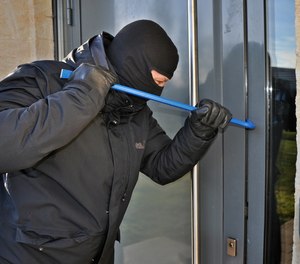Securing your home to keep your family safe requires mostly time, clear thinking and practice, not a large expenditure of funds
Just in case you’ve slept through the last few years of police attack statistics, I’ll summarize them for you ‒ you are being hunted!
Ranging from ambush attacks during bogus calls for help to targeting off-duty officers at their homes, officers face a dangerous world. At least once every year for the last several years, an officer’s home has been attacked by a criminal they have never before contacted. When the facts are sorted out, the presence of a marked police car at the home is often what drew the attacker to the residence.
At least while on duty you are armed, probably wearing body armor and have access to instant communications with help. At home, off-duty and unaware, you will likely face an attacker alone and under-armed. Threatening your life is bad enough, but your family didn’t sign up for such danger.

It is time you prepared yourself, your family and your home for a worst-case scenario. Make your home your castle with these six steps.
1. KEEP A LOW PROFILE
A marked take-home squad car in the driveway is the most obvious indicator a cop lives in the house. Is driving a personal car to/from work a better idea? Can the squad car be concealed in a garage or behind a building? In an apartment complex, park the company car away from your residence building. Another giveaway is a “blue line” flag flying at your home.
2. DEVELOP A FAMILY EMERGENCY ACTION PLAN
This should be an all-hazard plan covering fires (both structural and area wildland fires), medical emergencies, natural disasters like a flood or tornado and, of course, attack by an armed intruder.
Have a plan simple enough for your youngest child to understand and drill the plan often enough to commit it to memory. Pre-planned escape routes and rally points will get your family out of danger and reunited in a safe location. The plan should include a shelter-in-place component including some sort of “safe room” should an attacker gain entry. Something as simple as a full-size bed can provide substantial ballistic protection, as mattresses are very difficult to shoot through from side-to-side. Make sure battery-powered lighting and communications devices like cellphones are charged and readily available.
3. HARDEN TARGETS
While a deadbolt lock is an obvious way to secure a door, consider the door itself in your plan. Hollow-core wooden doors are commonly used inside homes, but some homes have poor quality exterior doors as well. Do the doors have windows or side windows large enough to allow entry to an attacker or even just a way to reach inside and unlock the door? Windows and patio doors should be locked, or better yet, physically blocked with a simple stick that prevents them from being opened. Large glass elements cannot be readily hardened, but generally give loud notice when broken. Motion-activated lights around your home are inexpensive and effective deterrents.
4. GATHER INTEL
Home security cameras and intrusion sensors are inexpensive these days, easy to install and can be connected to notification systems to automatically alert help. The cameras that link to smartphones via your home’s Wi-Fi system give you real-time video to see what threat you are facing and where it is moving through your home. A barking dog is an insurance policy to let you know when the boogeyman visits while you are asleep.
5. ENSURE ACCESS TO COMMUNICATIONS
I already mentioned battery-powered communications devices like a cellphone, which can double as your security camera monitor. If you have a take-home portable police radio, have it ready in the charger to bypass the 911 phone lines and talk directly to your responding help, thereby saving precious minutes.
6. REPEL BOARDERS
With children in the house, most of us have a secure location for our duty sidearm. If that is not in your bedroom, do you have another firearm secured there for instant use? A compact long gun may be a better choice for your adult family members, offering better hit probability and generally more power than your sidearm.
Beware of having too much power in a long gun. The interior walls of most homes provide little resistance to bullets. Lighter, more frangible bullets for rifles and smaller shot sizes for shotguns can still be devastatingly effective at short range, but less likely to endanger those in other rooms (or even other buildings in tightly stacked housing environments).
Consider how to use furniture or lighting to funnel intruders to specific “kill points” where you can engage them with heavy furniture or appliances in the background to stop bullet overpenetration.
You don’t need to spend $2,500 on a tricked out M4 for home defense (but they are fine if you have one to spare). Simple, manually operated long guns are perfectly adequate and can be more easily trained to your family members charged with armed defense.
I am preaching preparation, not paranoia, so assess your own needs sensibly. Making your home and family safe from all types of threats requires mostly time, clear thinking and practice, not a large expenditure of funds. The list above is simple. Develop what you need for your particular environment.
Not here. Not today. Today my family will be safe.


